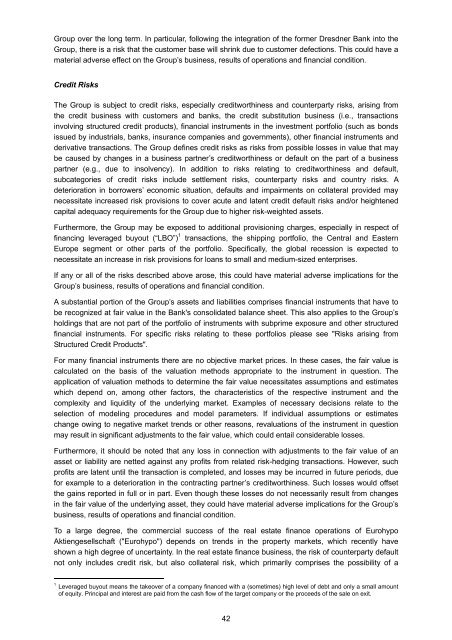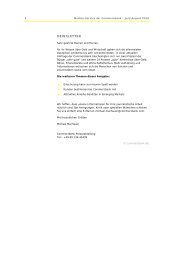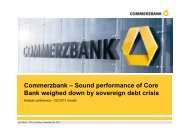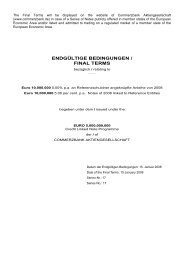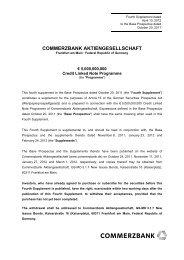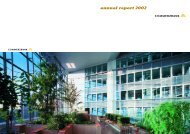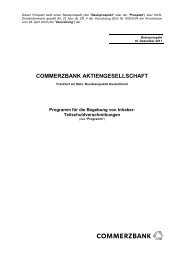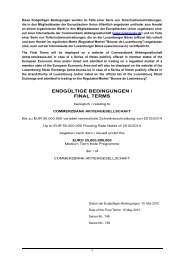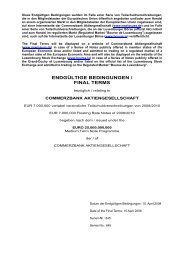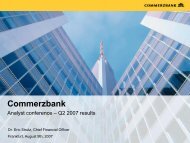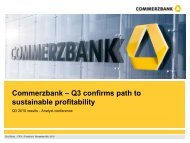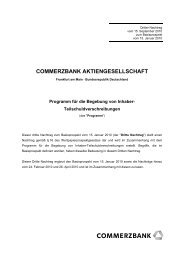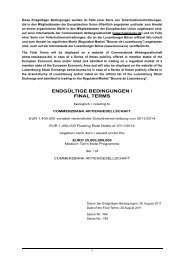COMMERZBANK AKTIENGESELLSCHAFT
COMMERZBANK AKTIENGESELLSCHAFT
COMMERZBANK AKTIENGESELLSCHAFT
Create successful ePaper yourself
Turn your PDF publications into a flip-book with our unique Google optimized e-Paper software.
Group over the long term. In particular, following the integration of the former Dresdner Bank into the<br />
Group, there is a risk that the customer base will shrink due to customer defections. This could have a<br />
material adverse effect on the Group’s business, results of operations and financial condition.<br />
Credit Risks<br />
The Group is subject to credit risks, especially creditworthiness and counterparty risks, arising from<br />
the credit business with customers and banks, the credit substitution business (i.e., transactions<br />
involving structured credit products), financial instruments in the investment portfolio (such as bonds<br />
issued by industrials, banks, insurance companies and governments), other financial instruments and<br />
derivative transactions. The Group defines credit risks as risks from possible losses in value that may<br />
be caused by changes in a business partner’s creditworthiness or default on the part of a business<br />
partner (e.g., due to insolvency). In addition to risks relating to creditworthiness and default,<br />
subcategories of credit risks include settlement risks, counterparty risks and country risks. A<br />
deterioration in borrowers’ economic situation, defaults and impairments on collateral provided may<br />
necessitate increased risk provisions to cover acute and latent credit default risks and/or heightened<br />
capital adequacy requirements for the Group due to higher risk-weighted assets.<br />
Furthermore, the Group may be exposed to additional provisioning charges, especially in respect of<br />
financing leveraged buyout (“LBO”) 1 transactions, the shipping portfolio, the Central and Eastern<br />
Europe segment or other parts of the portfolio. Specifically, the global recession is expected to<br />
necessitate an increase in risk provisions for loans to small and medium-sized enterprises.<br />
If any or all of the risks described above arose, this could have material adverse implications for the<br />
Group’s business, results of operations and financial condition.<br />
A substantial portion of the Group’s assets and liabilities comprises financial instruments that have to<br />
be recognized at fair value in the Bank's consolidated balance sheet. This also applies to the Group’s<br />
holdings that are not part of the portfolio of instruments with subprime exposure and other structured<br />
financial instruments. For specific risks relating to these portfolios please see "Risks arising from<br />
Structured Credit Products".<br />
For many financial instruments there are no objective market prices. In these cases, the fair value is<br />
calculated on the basis of the valuation methods appropriate to the instrument in question. The<br />
application of valuation methods to determine the fair value necessitates assumptions and estimates<br />
which depend on, among other factors, the characteristics of the respective instrument and the<br />
complexity and liquidity of the underlying market. Examples of necessary decisions relate to the<br />
selection of modeling procedures and model parameters. If individual assumptions or estimates<br />
change owing to negative market trends or other reasons, revaluations of the instrument in question<br />
may result in significant adjustments to the fair value, which could entail considerable losses.<br />
Furthermore, it should be noted that any loss in connection with adjustments to the fair value of an<br />
asset or liability are netted against any profits from related risk-hedging transactions. However, such<br />
profits are latent until the transaction is completed, and losses may be incurred in future periods, due<br />
for example to a deterioration in the contracting partner’s creditworthiness. Such losses would offset<br />
the gains reported in full or in part. Even though these losses do not necessarily result from changes<br />
in the fair value of the underlying asset, they could have material adverse implications for the Group’s<br />
business, results of operations and financial condition.<br />
To a large degree, the commercial success of the real estate finance operations of Eurohypo<br />
Aktiengesellschaft ("Eurohypo") depends on trends in the property markets, which recently have<br />
shown a high degree of uncertainty. In the real estate finance business, the risk of counterparty default<br />
not only includes credit risk, but also collateral risk, which primarily comprises the possibility of a<br />
1 Leveraged buyout means the takeover of a company financed with a (sometimes) high level of debt and only a small amount<br />
of equity. Principal and interest are paid from the cash flow of the target company or the proceeds of the sale on exit.<br />
42


